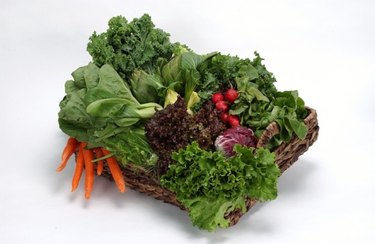
A raw food diet is based upon uncooked, unprocessed plant-derived foods. Staples of the diet include organic fruits and vegetables, sprouts, unprocessed grains, nuts, beans and seaweed. In some cases mildly heated foods, such as warm vegetable soup, are permitted. Depending upon the strictness of your diet, eating primarily raw foods may pose risks, including nutrient deficiencies and potentially serious illnesses. To learn healthy ways to incorporate raw food diet principles into your lifestyle, seek guidance from your dietitian.
Vitamin B12 Deficiency
Video of the Day
Vitamin B12 is a water-soluble nutrient that plays an important role in brain function, red blood cell production and DNA synthesis. People who consume a strict vegetarian or vegan diet are at risk for vitamin B12 deficiency since the nutrient only occurs naturally in animal-derived foods, such as dairy products, meat and fish. While fortified breakfast cereals are valuable sources of vitamin B12 for vegetarians, raw food diets typically do not contained processed breakfast cereals. Symptoms of vitamin B12 deficiency include fatigue, constipation, reduced appetite, numbness or tingling in your feet and hands, mouth soreness, balance problems, depression, poor memory and mental confusion. The Office of Dietary Supplements suggests addressing vitamin B12 deficiency promptly to prevent permanent damage. Treatment may include oral supplementation, vitamin B12 injections or dietary changes.
Video of the Day
Cholesterol Problems
Consuming a raw food diet may also negatively impact your cholesterol levels. According to research published in the "Journal of Nutrition" a raw food diet may improve your triglyceride levels, but hinder your HDL, or good, cholesterol. Forty-six percent of the raw food-dieters studied demonstrated abnormally low HDL cholesterol--a significant risk factor for heart disease. While some raw food-dieters include plant-based oils in their diets, many others do not, since oils do not occur naturally and require processing. Other foods that promote positive HDL levels, such as fish, seafood, peanut butter and whole grain breads and cereals, are also restricted or limited in most raw food diets. Eating too few acceptable raw fat forms, such as nuts, avocados and seeds, increases your risk for cholesterol problems.
Poor Bone Density
Eating too few calories, maintaining a low body weight and consuming deficient amounts of calcium and vitamin D are significant risk factors for osteoporosis--a condition characterized by weak, brittle bones. Since many raw food diets are based upon low-calorie foods, such as fruits, vegetables and sprouted grains, and low in denser foods, you may find it difficult to meet your daily caloric needs. While calcium is prevalent in some raw foods, such as green vegetables and almonds, you may not consume amounts required to meet your nutrient needs. For example, 1 cup of chopped raw broccoli provides roughly 43 g of calcium. One cup of milk provides 300 mg. In order to properly absorb calcium, your body requires roughly 600 to 800 international units of vitamin D per day. While you can reap vitamin D from sun exposure, available dietary sources of vitamin D include seafood, meat, eggs and fortified, dairy products foods typically not included in raw food diets. Consuming a strict, low-calorie raw food diet increases your risk for poor bone density, osteoporosis and resultant bone fractures significantly.
Related Reading
The raw foods diet emphasizes eating uncooked and unprocessed foods, often those that are organic or wild-grown and foraged foods. While raw food diets tend to be vegetarian or vegan in nature, eating raw animal products is permissible if you make that choice. Sashimi, as a source of healthy animal protein, is uncooked fish, which is allowed on a nonvegetarian raw foods diet.
About Sashimi
Sashimi is a type of sushi native to Japan, the first instances of which appeared over 200 years ago. Sashimi refers to thin slices of raw fish, which are sometimes cured or marinated lightly with soy sauce or alcohol to season the fish and preserve it. Sashimi can be made from a variety of fish and seafood; the most common are tuna, salmon, mackerel and yellowtail.
Raw Food Diet and Animal Products
Raw food diets that include animal products allow for fish and seafood, as well as other meats that can be safely eaten raw, including dairy, muscle meats such as beef, and in some cases, organ meats and eggs. As with vegetarian raw food diets, the animal products cannot be heated over 104 degrees Fahrenheit. Supporters of raw food diets consider eating food cooked over this temperature limit to have lost the majority of its nutritional value. Sashimi, as it is left entirely uncooked, is allowed on a raw foods diet, as are other raw meat dishes, such as steak tartare.
Sashimi Safety and Benefits
The U.S. Department of Agriculture recommends eating a minimum of 8 ounces of fish or seafood as a protein choice each week. Many fish and other seafood are high in omega-3 fatty acids, which can help reduce your chances of cardiovascular disease. To ensure the sashimi you eat is safe, choose sushi-grade fish, which has been checked, tested and approved for eating raw. Vary the type of sashimi you eat to ensure you get a range of different nutrients. When purchasing fish, let your fishmonger know you plan to eat it raw.
Vegetarian and Vegan Raw Foods Diet
Most raw food followers practice a vegetarian or vegan raw foods diet. These practitioners do not consume muscle meats, such as fish for sashimi, but raw milk and raw milk products, as well as raw eggs may be allowed for those on a vegetarian diet. A vegan raw foods diet abstains from all animal products, so milk, cheese and eggs are not allowed, although in some cases raw honey is included.